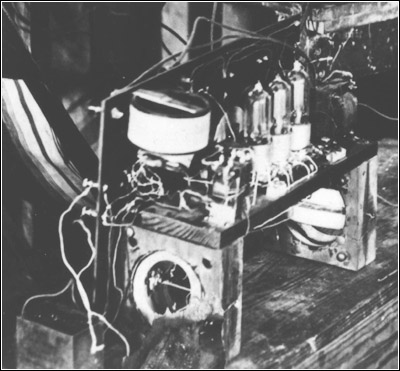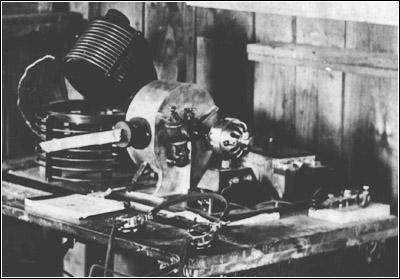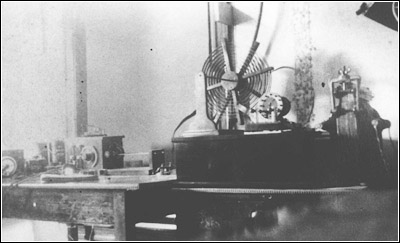Of Old Radios And Related Items--Published Monthly
Early Wireless Station
CONTRIBUTED BY DON IVERSON, JIM CHEW, AND JIM KREUZER
WEB EDITION
This article grew out of Don Iverson's discovery of the photo on our cover in his archives. Don told us that long ago a "picker" (a person who goes to hundreds of sales and buys things like albums) brought the photo to his shop, knowing that he collected wireless equip-ment. The fellow had no idea where the photo had come from and Don hasn't seen him since. The photo contents are so interesting that we've done our best to have them identified by a few wireless experts and to share their observations with you. (Editor)
This picture is so fascinating that volumes could be written from just what can be seen. The setting is obviously post-World War I and is the property of someone of more than adequate means. The components are store-bought, though the wiring leaves room for improvement, to say the least.
The mystery of who owned this station adds to the photo's interest, though it is doubtful that he was anyone who became famous. Still, one can visualize him as he pounded away on that handkey, and wonder if he ever made contact with anyone else.
It appears from the tubes and rotary spark transmitter that this high-power Ham station dates from around 1917 to 1921. Since we entered the war at the end of 1917, the Army recruiting poster on the wall is another indication of that era. The poster says,"Signal Corps Trains Men for Radio" at the top, and "U.S. Army Recruiting Office" at the bottom. The hanging lamp and the sling chair help to evoke a vision of an operator with a green eyeshade. The haphazard wires suggest that this is an amateur's wireless corner.
Figure 1. The World War I era wireless receiver, an enlarged view from the cover of this issue.
The Receiver
The section of the cover photo in Figure 1 shows the receiver in the foreground on the bench. It uses three VT-1 tubes, which were sold as Army surplus. It also uses wooden variometers, probably in a tuned plate/tuned grid circuit -- a sign of early construction. Two stages of audio amplification are also included.
In the lower right corner, two alligator clips are visible. They appear to connect to a lead-acid battery to power the tube filaments. In front of the receiver, a B battery can be seen. The headset is in front of the transmitter.
The Transmitter
The transmitter is shown in Figure 2, another section of the cover photo. A Bell rotary spark gap with a general purpose electric motor is in the center of the operating table. The rotary spark gap has been modified with the addition of an oil cap an experimental method to improve the tone of the signal by adding a small amount of hydrocarbon vapor (kerosene, etc.) to the spark chamber. An adjustable oscillation transformer behind the gap looks as if it had been made by the William B. Duck Company. The rotary gap and oscillation transformer are connected by a metal strap.
A nice transmitting condenser is to the right of the gap, as is the sending key, which appears to be a Clapp-Eastham spark key on a marble base. This key had to be very heavily made, as it directly keyed the spark transformer primary from 110 VAC.
OTHER PHOTOS?
In all, this photo is a snapshot in time, a glimpse of how our own "radio shacks" of the 1920s might have looked. Below is another such photo, and no doubt, there are many more out there that we might all share. We invite you to send them in with as much of their history as possible. One article almost always leads to another.
Photo Credit: Don Iverson
(Don Iverson, 10115 N.W. St. Helens Rd., Portland, OR 97231; Jim Chew, 900 N. 4th St., Jeannette, PA 15644; Jim Kreuzer, P. O. Box 398, Elma, NY 14059)
Figure 2. The World War I era wireless transmitter, an enlarged view from the cover of this issue.
Another Early Wireless Station
From the collection of John V. Terrey
A wireless station photo from your editor's collection. Unlike our cover photo, which was sent to wireless experts for comment, we invite you readers to comment on the contents of this photo: a rheostat, loose coupler, helex rotary sparkgap, etc. Help us to write a story about this photo.
| [Free Sample] [Books, etc., For Sale] [Subscribe to A.R.C./Renew] [Classified Ads] [Auction Prices] [Event Calendar] [Links] [Home] [Issue Archives] [Book Reviews] [Subscription Information] [A.R.C. FAQ] URL = http://www.antiqueradio.com/early_wireless_05-00.html Copyright © 1996-2000 by John V. Terrey - For personal use only. Last revised: April 29, 2000. For Customer Assistance please contact ARC@antiqueradio.com or call (978) 371-0512 Pages designed/maintained by Wayward Fluffy Publications
Antique Radio Classified |


